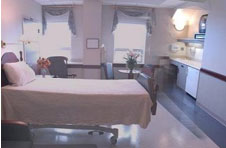Labor & Delivery
Maternal Child Pavilion
 Labor and Delivery Information
Labor and Delivery Information
If you are transferred to the Labor and Delivery Unit, you can expect the following:
- During labor, you will be placed on a fetal monitor for intermittent or continuous monitoring for your contractions and baby’s heart rate.
- You will be assigned a labor nurse who will be there to assist you throughout your labor and during your delivery. This registered nurse will evaluate your condition frequently and communicate with you regarding your plan of care.
- A resident physician will review your progress periodically and collaborate directly with your Obstetrician/Gynecologist.
- Learn more about Monitoring and Special Procedures (pdf)
Our expert team of anesthesiologists, who are on the unit around the clock, resident physicians and labor nurses will assist your obstetrician in providing you with a safe and meaningful birth experience.
Labor & Delivery Suites
 Our private birthing rooms, equipped with birthing beds, are designed to
blend home-like, comfortable surroundings with the most up-to-date technology
and equipment. The Labor & Delivery Suite consists of 18 private birthing
rooms, four traditional delivery rooms and a large recovery room. All
our birthing rooms are private and have birthing beds. If you have a vaginal
delivery, you will recover in the birthing room. If delivery is by cesarean
birth you will recover in our large recovery room until stable.
Our private birthing rooms, equipped with birthing beds, are designed to
blend home-like, comfortable surroundings with the most up-to-date technology
and equipment. The Labor & Delivery Suite consists of 18 private birthing
rooms, four traditional delivery rooms and a large recovery room. All
our birthing rooms are private and have birthing beds. If you have a vaginal
delivery, you will recover in the birthing room. If delivery is by cesarean
birth you will recover in our large recovery room until stable.
Your birth partner plus one additional visitor may be present during labor. The nursing staff will issue proper identification passes. We are unable to provide childcare for siblings.
Birth Plan
Writing a birth plan gives you an opportunity to write out your wishes on how you would ideally like your baby’s birth to be handled. A written plan will also refresh your physician’s (or covering physician’s) memory when you are in labor.
Cesarean Birth and Neonatologist
 Cesarean birth is considered a high-risk procedure for both mother and
fetus. Reasons behind performing cesarean section, combined with the complications
associated with surgical procedure (C-section) increase the risk of the
newborn infant being unstable, sick and asphyxiated at birth.
Cesarean birth is considered a high-risk procedure for both mother and
fetus. Reasons behind performing cesarean section, combined with the complications
associated with surgical procedure (C-section) increase the risk of the
newborn infant being unstable, sick and asphyxiated at birth.
The American College of Obstetrics and Gynecology and American Academy of Pediatrics, jointly stress the importance of a qualified individual skilled in initiating resuscitation and being available at every high-risk delivery. Thus, obstetricians routinely request the presence of a Neonatologist who is specialized in newborn intensive care, at the labor and delivery room so that an infant can be resuscitated and stabilized within seconds of birth. This service is accepted and approved by all insurance carriers.
Skin-To-Skin Contact

Skin-to-skin contact immediately after birth if medically stable is encouraged. Here at Cooperman Barnabas Medical Center we recognize the importance of the “Golden Hour”, the first hour after birth. We recommend this intimate hour to be reserved for the infant, mother and her significant other to allow the family the opportunity to enjoy the first hour of life privately bonding together. Breastfeeding mothers will be initiating the first feeding at this time.
After delivery you will be transferred to a Family Centered Care Unit.
For more information, please read our Frequently Asked Questions.



